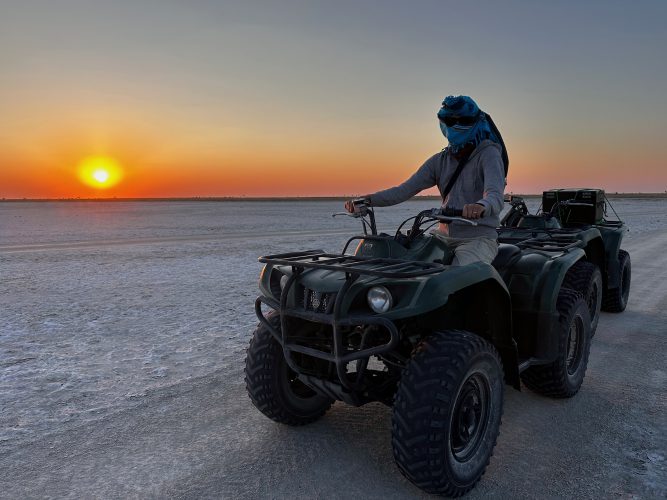From watching elephants cavorting and drinking at the Chobe River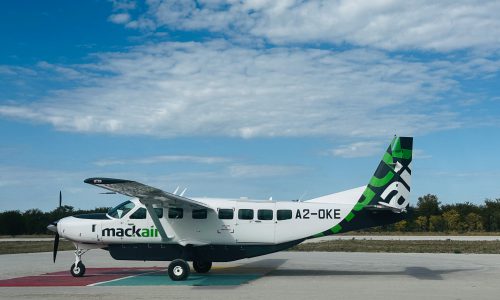 to my first whiff of wild sage at Selinda to hearing a lioness calling to her cubs in Khwai, to the surreal sunsets over the Makgadikgadi salt pans, my safari in Botswana was a feast for the senses. The country offers an immersive wildlife experience in remote, pristine wilderness areas, often only accessible by air, and I had a thrilling time flying over the Delta in Cessna Grand Caravans or helicopters.
to my first whiff of wild sage at Selinda to hearing a lioness calling to her cubs in Khwai, to the surreal sunsets over the Makgadikgadi salt pans, my safari in Botswana was a feast for the senses. The country offers an immersive wildlife experience in remote, pristine wilderness areas, often only accessible by air, and I had a thrilling time flying over the Delta in Cessna Grand Caravans or helicopters.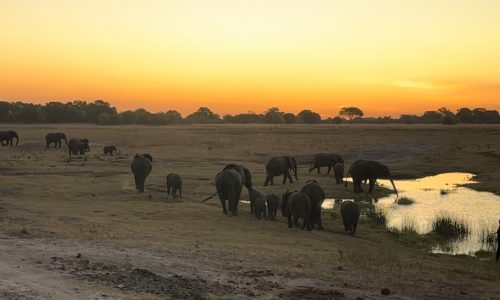
After a 2-hour flight from Johannesburg, my adventure began in Kasane, Botswana, gateway to Chobe National Park. At approximately the size of Belgium, with about 60 miles of riverfront along the Chobe River, the park is home to one of Africa’s largest elephant populations, with herds sometimes numbering in the hundreds.
My safari began at Chobe Elephant Camp just west of the park, and on our first game drive, we saw elephants, antelope, zebra, giraffe, hippo, and even a leopard. The camp’s comfortable “farmhouse” style rooms, with white walls, cement floors, and exposed wood beams, offered a relaxing retreat. A full-day excursion included a game drive and a boat ride on the Chobe River, where we got up close to elephants, crocodiles, hippos, and buffalo. I also stopped to visit the neighboring Ngoma Safari Lodge, with just eight rooms overlooking the river, offers an intimate safari-style accommodation. Heading east I visited the serene Chobe Chilwero Lodge, before spending the night on the river at Chobe Game Lodge. Taking advantage of its location inside the park and on the river, allowed for some quieter mornings in the bush before the park opened to other guests, and the option of sunrise-, afternoon-, and sunset cruises. For first-time visitors, a larger lodge like this, with all its creature comforts and amenities, is often a comfortable and convenient way to ease into the safari life.
first game drive, we saw elephants, antelope, zebra, giraffe, hippo, and even a leopard. The camp’s comfortable “farmhouse” style rooms, with white walls, cement floors, and exposed wood beams, offered a relaxing retreat. A full-day excursion included a game drive and a boat ride on the Chobe River, where we got up close to elephants, crocodiles, hippos, and buffalo. I also stopped to visit the neighboring Ngoma Safari Lodge, with just eight rooms overlooking the river, offers an intimate safari-style accommodation. Heading east I visited the serene Chobe Chilwero Lodge, before spending the night on the river at Chobe Game Lodge. Taking advantage of its location inside the park and on the river, allowed for some quieter mornings in the bush before the park opened to other guests, and the option of sunrise-, afternoon-, and sunset cruises. For first-time visitors, a larger lodge like this, with all its creature comforts and amenities, is often a comfortable and convenient way to ease into the safari life.
In the Selinda Reserve, nestled between Chobe National Park and the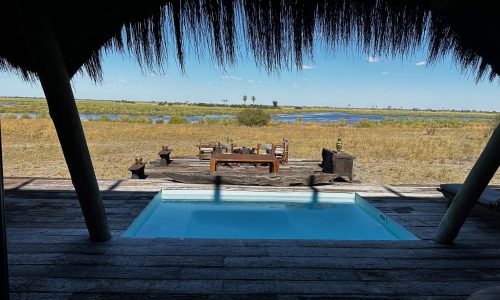 Okavango Delta, I was fortunate to stay at Selinda Camp– and Selinda Explorers Camp and paid a visit to Zarafa Camp. The sense of remoteness here was profound (I encountered only one other vehicle during my stay), yet all of these camps lived up to their reputation for delicious food, paired with excellent wines and stunning views. The golden grasslands provided a particularly perfect backdrop while following a leopard on the prowl.
Okavango Delta, I was fortunate to stay at Selinda Camp– and Selinda Explorers Camp and paid a visit to Zarafa Camp. The sense of remoteness here was profound (I encountered only one other vehicle during my stay), yet all of these camps lived up to their reputation for delicious food, paired with excellent wines and stunning views. The golden grasslands provided a particularly perfect backdrop while following a leopard on the prowl.
I headed to Linyanti next. This is a private concession bordering Chobe 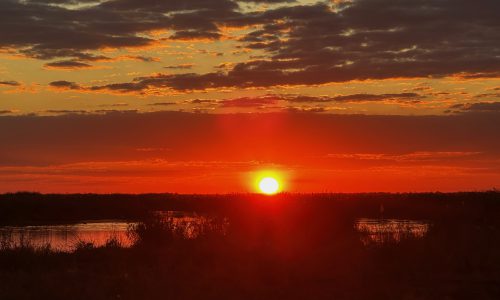 National Park, where I stayed at Linyanti Bush Camp, on the banks of the Linyanti Marsh, near its sister camp, Linyanti Ebony. The highlight was an afternoon game drive through the wetland, where we saw herds of buffalo, elephants, impala, kudu, waterbuck, and red lechwe, and tracked a lion after dark. If only I had more time, I could have enjoyed other activities, such as a scenic helicopter flight and nature walks.
National Park, where I stayed at Linyanti Bush Camp, on the banks of the Linyanti Marsh, near its sister camp, Linyanti Ebony. The highlight was an afternoon game drive through the wetland, where we saw herds of buffalo, elephants, impala, kudu, waterbuck, and red lechwe, and tracked a lion after dark. If only I had more time, I could have enjoyed other activities, such as a scenic helicopter flight and nature walks.
My journey continued to the Okavango Delta though, and my first stop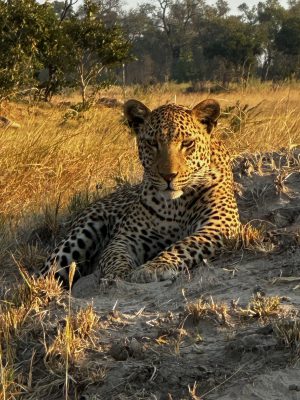 was the Stanley’s concession bordering the Moremi Game Reserve. I stayed at the inimitable Baines Camp, built on stilts above the Boro River, with outdoor bathtubs, and beds that could be rolled out onto the deck for stargazing. The game drives were very fruitful, with sightings of a mother leopard and her cub, a pride of 14 lions, zebra, a honey badger, elephants, and a male lion while out on a night drive. We were also enchanted by a hyena mother and her pups at their den.
was the Stanley’s concession bordering the Moremi Game Reserve. I stayed at the inimitable Baines Camp, built on stilts above the Boro River, with outdoor bathtubs, and beds that could be rolled out onto the deck for stargazing. The game drives were very fruitful, with sightings of a mother leopard and her cub, a pride of 14 lions, zebra, a honey badger, elephants, and a male lion while out on a night drive. We were also enchanted by a hyena mother and her pups at their den.
Atzaro is accessible only by helicopter, so the camp is a combination of luxury and isolation, featuring a wine cellar, spa, gym, pool, and expansive suites, and the game drives did not disappoint: Spotting an aardwolf after tracking wild dogs was a highlight.
Moremi Game Reserve, located in the northeastern part of the  Okavango Delta, comprises a diverse landscape of woodlands, savannas, waterways, and floodplains. I stayed at Camp Moremi, nestled among Marula trees on the Maunachira River, (where I spotted the resident Pel’s Fishing Owl at the neighboring sister camp, Xakanaxa ) and Camp Okuti, just a short distance away. After a delightful sundowner with clients who were also in camp, I wished for more time to enjoy a boat safari but the next day I had to head to the airstrip, where we waited for an elephant to cross before boarding a short flight to Khwai. The Khwai River is an excellent destination for water experiences before the floods reach the Delta.
Okavango Delta, comprises a diverse landscape of woodlands, savannas, waterways, and floodplains. I stayed at Camp Moremi, nestled among Marula trees on the Maunachira River, (where I spotted the resident Pel’s Fishing Owl at the neighboring sister camp, Xakanaxa ) and Camp Okuti, just a short distance away. After a delightful sundowner with clients who were also in camp, I wished for more time to enjoy a boat safari but the next day I had to head to the airstrip, where we waited for an elephant to cross before boarding a short flight to Khwai. The Khwai River is an excellent destination for water experiences before the floods reach the Delta. 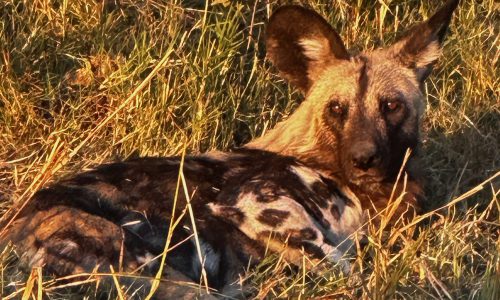 I stayed at Khwai Leadwood and Sable Alley, and during a game drive between camps, we encountered not one, but two pairs of mating lions! On one memorable drive, we tracked wild dogs and arrived just in time to witness them finish off the remains of a red lechwe before racing back to their den to feed their young. It was exhilarating, and my guide, MD, who had been guiding for 14 years, exclaimed, “I love these animals!” The enthusiasm and expertise of guides like MD, who share a deep passion for Botswana and its wildlife, allow guests to experience the magic of the bush through their eyes.
I stayed at Khwai Leadwood and Sable Alley, and during a game drive between camps, we encountered not one, but two pairs of mating lions! On one memorable drive, we tracked wild dogs and arrived just in time to witness them finish off the remains of a red lechwe before racing back to their den to feed their young. It was exhilarating, and my guide, MD, who had been guiding for 14 years, exclaimed, “I love these animals!” The enthusiasm and expertise of guides like MD, who share a deep passion for Botswana and its wildlife, allow guests to experience the magic of the bush through their eyes.
Just when I thought I had seen all the wonders Botswana had to offer, 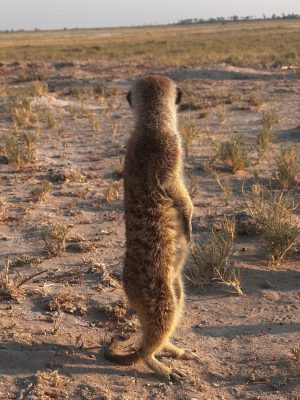 I flew to central Kalahari, landing at Tsigaro Airstrip, where I found myself in a tent reminiscent of Arabian Nights, sipping a mimosa. This enchanting theme continues across Jacks Camp, San Camp, and Camp Kalahari – all perfect for exploring the surreal, shimmering white landscapes of the Makgadikgadi salt pan remnants of an ancient lake. While we did spot wildebeest, bat-eared foxes, springhares, Kori bustards, elephants, zebras, mongoose, jackals, ostriches, and even tracked an aardvark on foot, the real star was the vast night sky and the unique activities on offer—quad biking, meerkat encounters, and Bushman walks. It was the perfect ending to an epic journey through Botswana.
I flew to central Kalahari, landing at Tsigaro Airstrip, where I found myself in a tent reminiscent of Arabian Nights, sipping a mimosa. This enchanting theme continues across Jacks Camp, San Camp, and Camp Kalahari – all perfect for exploring the surreal, shimmering white landscapes of the Makgadikgadi salt pan remnants of an ancient lake. While we did spot wildebeest, bat-eared foxes, springhares, Kori bustards, elephants, zebras, mongoose, jackals, ostriches, and even tracked an aardvark on foot, the real star was the vast night sky and the unique activities on offer—quad biking, meerkat encounters, and Bushman walks. It was the perfect ending to an epic journey through Botswana.
